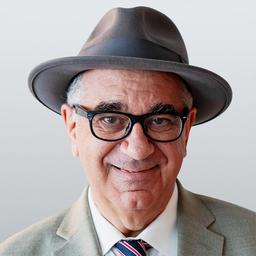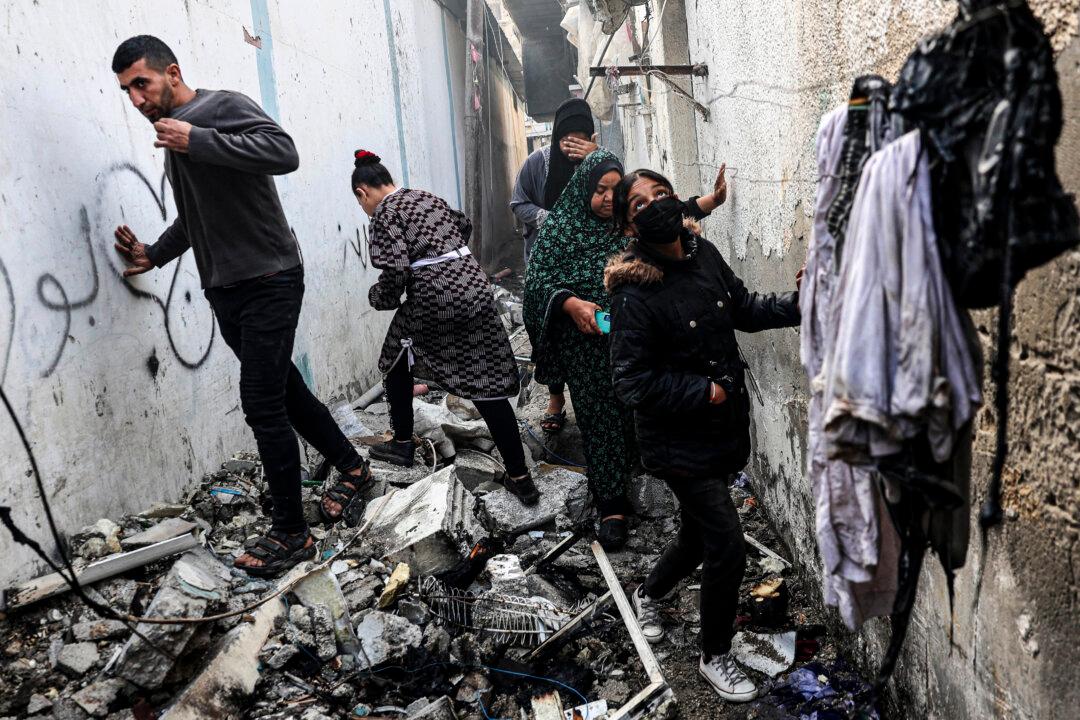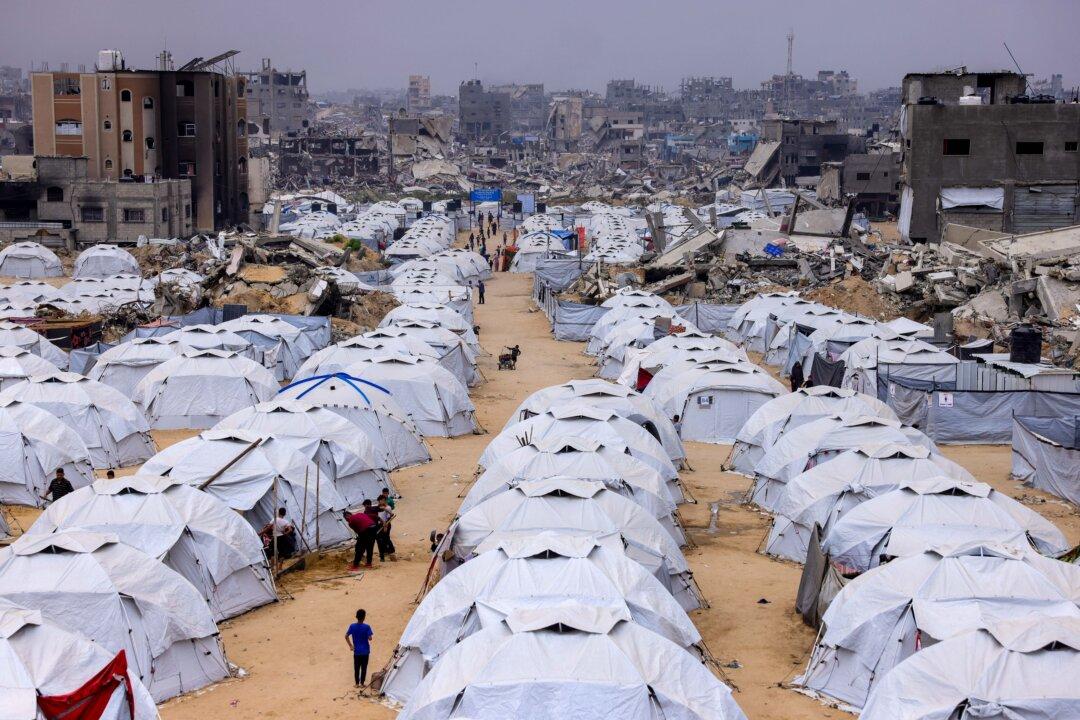After a weekend of intense strikes across the Lebanese frontier, Israel and Hezbollah sent signals that, while not done fighting, they were standing down from any significant escalation that risks a wider war.
Hezbollah launched what Israel reported were 230 rockets—Hezbollah said 340—and almost two dozen UAVs, but not before 100 Israeli warplanes attacked thousands of Hezbollah rocket launchers in a pre-emptive strike early Sunday morning, Aug. 25.
Each side said they had only struck military targets. Lebanese authorities said three people were killed in the Israeli strikes. The IDF did not refer to damage or casualties on Israel’s side, and on Monday, there was little reference to any damage or casualties by Israel’s press and television.
Neither side said they were done.
Hezbollah leader Hassan Nasrallah said that Sunday’s strike was in retaliation for Israel’s targeted airstrike killing top military commander Fuad Shukr last month and did not rule out another retaliatory strike. That hit, Israel said, was retaliation for Hezbollah’s rocket attack on a soccer field that killed a dozen Israeli Druze children and teens.
Hezbollah’s patron, Iran, for its part, remains intent on retaliating against Israel for its presumed involvement in assassinating Hamas leader Ismail Haniyeh in Tehran a few hours after Shukr’s death. Israel has not acknowledged any role in Haniyeh’s killing.
Israeli Prime Minister Benjamin Netanyahu said of the exchange of fire on Sunday, “This is not the end of the story.”
300 Rockets, Pre-Emptive Action
Nasrallah implied that Hezbollah’s attack had done significant damage to its targets. In a speech on Sunday after the attack, he said the main targets had been the Unit 8200 military intelligence base at Glilot and an air defense base at Ein Shemer.“Our data confirms that a significant number of UAVs have reached these two targets, but the enemy remains silent. The days and nights will pass and the truth about what happened there will be revealed.” he said.
“All we wanted to launch in this operation was 300 rockets, but we launched 340 rockets and the enemy did not thwart anything,” he said.
“The response was satisfactory, and it seems that elimination is enough,” he said. But he reserved the right to carry on its attack on Israel if Hezbollah deemed it necessary.
Rear Admiral Daniel Hagari, the IDF’s spokesman, said while the attack was underway with Hezbollah staging its missiles and rockets, Israel had struck “proactively.”
Its pre-emptive attack came within an hour after the IDF “identified extensive preparation by the Hezbollah terrorist organization to fire toward the Israeli Home Front,” he said.
Hagari warned civilians in south Lebanon that “Hezbollah is firing extensively into Israeli territory near your homes—you are in danger. We are targeting and removing Hezbollah’s threats.”
Hezbollah has launched more than 6,700 rockets, missiles, and explosive UAVs at Israel since Oct. 8, 2023, when it joined in after Hamas’s large-scale Oct. 7 attack on Israel, Hagari said.
“Israel will not tolerate Hezbollah’s attack on our civilians,” he said.

The IDF’s chief of staff, Lieutenant General Herzi Halevi, said, “We are very determined to change the security reality in the north.”
In an IDF post on the Telegram social media platform, Halevi alluded to the forced evacuation of more than 80,000 Israeli civilians, most from communities within five kilometers of the border but also others a little further who are still vulnerable to rocket and missile fire by Hezbollah.
First Hamas, Then Hezbollah
Since early spring, Israeli military analysts had predicted the IDF would soon vanquish Hamas in Gaza and then, redeploy for a ground war against Hezbollah, with dry summer weather enabling air strikes, artillery spotting, and armor movement in a more conventional war to the now-sparsely populated north, in contrast to the heavily urban combat characteristic of Gaza.
That hasn’t happened, as Hamas, fighting more guerrilla-style after losing so many fighters, weapons, and installations to the IDF, forced the Israelis to resume fighting in areas previously regarded as pacified.
Halevi didn’t give evacuees any hope that the IDF would be able to destroy Hezbollah soon. Northern schools have not reopened for the fall term as families had hoped they would.
Halevi noted the Gaza front as the IDF’s continuing priority.
“We are very determined and will continue to do everything to protect the citizens of Israel in every area,” he said.
“We are focused in the Gaza Strip on dismantling Hamas and bringing back the hostages,” he said. “The pressure we are applying in operations in Gaza is the pressure that will bring about the return of the hostages.
“In parallel, we are operating against Hezbollah in Lebanon, continuing to systematically degrade them.”
Gaza cease-fire negotiations in Cairo continued even as Sunday’s rocket and air war was underway. National Security Council spokesperson John Kirby said on Monday that the flare-up between Israel and Hezbollah had “no impact” on the negotiations held in Cairo between Israel and Hamas.

“It has not affected the actual work on the ground by the teams trying to get the cease-fire deal in place,” Kirby said.
Probing for Weakness?
The Institute for the Study of War, a Washington-based strategic think tank, gave a more detailed analysis of the battle. It said the attack by Hezbollah may have been a “reconnaissance in force,” a probe testing Israeli defenses to benefit upcoming strikes from Iran, Yemen’s Houthi rebels, or others.The ISW said on its website that Hezbollah delivered a two-stage attack on Aug. 25.
The first stage, against 11 IDF sites in northern Israel, used imprecise and scattered attacks to distract air defense to allow the second stage, including more precise strikes against the targets of Glilot, Ein Shemer, and others, a better chance of success.
“Hezbollah meant for its attack to be much larger than it was,” the ISW said.
The Israelis, in their preemptive attack 30 minutes before the Hezbollah attack’s presumptive start time at 5 a.m. local time, took out 50 to 67 percent of the weapons meant to have been used in Hezbollah’s attack, the ISW said, citing Israeli Defense Minister Yoav Gallant as their source.
The ISW repeated the IDF’s assertion that it took out “thousands” of rocket launchers. It destroyed 200 installations at 40 locations “within minutes,” the ISW said.
The ISW noted, though, that Hezbollah might have positioned more rocket launchers than it intended to use “in order to obfuscate the direction and scale of its attack,” and might not have intended to use them all.
The ISW suggested that the retaliations against Israel are not yet over and might be “staggered” in time. The Houthis may yet retaliate for the IDF’s air strike against their port on July 20, in turn, a retaliation for a Houthi missile strike on a Tel Aviv apartment building the previous day.







